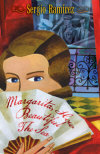Margarita, How Beautiful the Sea
The prolific Nicaraguan writer Sergio Ramírez is almost unknown in this country. Only a handful of his thirty or so books have been translated into English, and just two appear to be in print in the United States, including Margarita, How Beautiful the Sea, which won the Alfaguara Prize, a major Spanish literary award, a decade ago. Margarita, translated by Michael B. Miller, is an ambitious, sweeping and beguiling work whose action spans more than half a century. With its huge cast of poets, journalists, generals, intelligence agents, failed cotton barons, whiskey priests, dictators, and many others (a character list at the end of the book runs eight pages and contains 75 names), it is a Nicaraguan national epic.
The prolific Nicaraguan writer Sergio Ramírez is almost unknown in this country. Only a handful of his thirty or so books have been translated into English, and just two appear to be in print in the United States, including Margarita, How Beautiful the Sea, which won the Alfaguara Prize, a major Spanish literary award, a decade ago. Margarita, translated by Michael B. Miller, is an ambitious, sweeping and beguiling work whose action spans more than half a century. With its huge cast of poets, journalists, generals, intelligence agents, failed cotton barons, whiskey priests, dictators, and many others (a character list at the end of the book runs eight pages and contains 75 names), it is a Nicaraguan national epic.
Margarita’s plot unfolds along two main lines. One centers on the return of the modernist poet Rubén Darío to his native León in 1907, after many years abroad. The other, climaxes in the 1956 assassination of the ruthless American-backed dictator Anastasio Somoza. The assassin is another poet, Rigoberto López Pérez, a student of Darío’s life and work.
Ramírez’s Darío is in flight from a wife he loathes (“La Maligna”), nearly destitute, poisoned in his early forties by hard drinking, yet still a gifted poet, still capable of generosity and grace. He begs off an official reception because he would rather teach Chiron, an illiterate servant boy, how to read; he claims to have infused Chiron with the numen, “the spirit of the muses.” By contrast, Somoza, a onetime latrine inspector now dressed in Palm Beach white, accented with a silver cigarette holder and bulletproof vest, is a flat figure – corrupt, banal, and unredeemed.
When Darío disembarks on Nicaraguan soil, Eulalia, a glamorous woman “with thick, knitted eyebrows and a diadem on her forehead” recites some of his verses in greeting: “As I steered my boat for Cythera / I greeted the waves, and the waves replied / with the happy sound of female voices.” To Darío’s eyes Eulalia is a vision in “snow, charcoal, and ash,” while her words catch on the Pacific breeze. Compare that to the reception accorded Somoza when he steps out of his armored limousine before a sham constitutional congress. His henchmen have trucked in supporters from León’s barrios with the promise of free rum and tamales. The crowd cheers: “Long Live The Man, the best goddamn man there is. You’re The Man, you’re The Man, goddamn right!”
The two plot lines are intricately linked. Darío writes a poem (whose opening line is also the novel’s title) on a fan held by a young girl, a girl who will grow up to be Somoza’s sister-in-law. Rigoberto is part of an amateurish circle of conspirators, all vaguely literary types, who seem more interested in talking about Darío than in planning Somoza’s murder. Norberto, another of the conspirators, woos Darío’s granddaughter, Zela the Moor. Zela’s father, Dr. Balthazar Cisne (husband of The Rose Child, Darío’s natural daughter with Eulalia), attempts to secure Somoza’s patronage for a set of electric lights to illuminate a statue of Darío in a León square. I could go on and on: in Ramírez’s Nicaragua, everyone seems to be related to everyone else, and the past is never laid to rest.
At times, Ramírez expresses his characters’ lack of agency through the recurring trope of the Fates, the three goddesses of human destiny, who spin their looms to manipulate the narrative events. More convincingly, Ramírez has his eyes on another, less mythological set of actors. Chiron, the once-illiterate servant boy who is now Darío’s numen-infused literary heir, sees a group of drunken American marines desecrate a cemetery. The editor of a León newspaper publishes Chiron’s account of the vandalism on his front page. In response, the marines beat Chiron unconscious, and while he eventually recovers, he has lost the powers of speech. The marines eventually depart Nicaragua, but the yanqui shadow remains. Sartorious Van Wynckle, a sinister American intelligence agent, oversees Somoza’s security force. Along with the men he has trained, Van Wynckle ensures that the anti-Somoza conspirators are arrested and tortured, and that Somoza’s sons succeed him into power. The imperial hand sets the course, and the Nicaraguans suffer.
While Ramírez is not a disinterested observer of power (he was active in the Sandinista regime that ruled following the 1979 collapse of the Somoza dynasty, and was Nicaragua’s vice-president from 1984-90), Margarita never strays into propaganda. Ramírez’s characters live through violence and poverty, but they also have friendship, rum, love, and, often miraculously, poetry.





